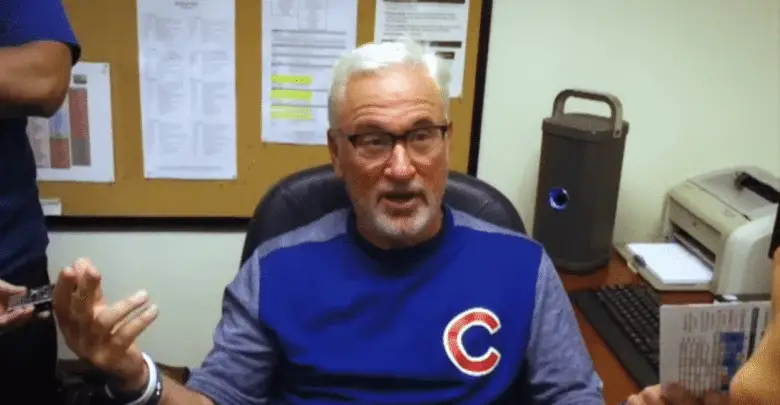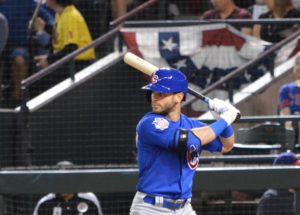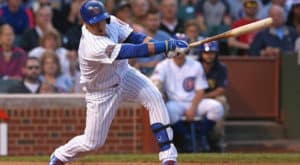
How Are Maddon’s Lineup Decisions Affecting Cubs’ Poor Production Against Power Pitchers?
With each game the Cubs play against top power arms, the evidence mounts that these pitchers are the offense’s Achilles heel. For all the talk about its up-and-down nature, when the Cubs face finesse and mixed-repertoire pitchers, they plate runs at a league-leading rate. When facing top power starters, however, they struggle far below league average (for more background, click here).
Later today, the Cubs take another crack at a top playoff-caliber power arm in Cleveland’s Trevor Bauer (10.22 K/9). This comes a week after Atlanta’s Mike Foltynewicz dominated the Cubs with 10 strikeouts over 5 innings.
The Cubs’ sole saving grace in that May 15 game proved to be accepting five walks from Foltynewicz. This helped drive his pitch count to 107 and him to an early shower. Then in the 9th, the Cubs strung together multiple hits for the first time in the game for a great come-from-behind victory.
Maximizing the roster
The offense’s struggles against power-arms naturally bring up trade questions. But before going there, let’s scrutinize how well Joe Maddon has leveraged his current hitters. This can better guide how much adding/subtracting may be needed by the trade deadline.
The Cubs have already faced 12 starting pitchers ranked in their league’s top 20 in either ERA or K/9 rate, and the below chart shows their individual performances against power arms as measured by Baseball-Reference.com. The last column shows the percentage of these games each Cubs hitter has started.
First, the top five (in blue) clearly out-perform their peers qualitatively.
Second, I’ve used career numbers for greater sample-size certainty. But interestingly, an examination of 2018 numbers only accentuates this spread. The top five hitters have all improved in 2018 on their career numbers. Meanwhile, six of the lower seven hitters are underperforming their career marks, with Ian Happ just nominally better. The most dramatic: Javy Baez with a .081 batting average and .317 OPS this year against power arms.

Third, Tommy La Stella’s success and under-use really stands out. His effectiveness against power arms, though, should not surprise. As an accomplished pinch hitter (over .400 this year alone), most of those at-bats come against hard-throwing bullpen arms. And yet, Maddon has started him just once against a top power starter this year.
Why Maddon hasn’t given La Stella more spot starts against such pitchers – especially as Baez struggles against the same pitchers – is a mystery.
Similar cases can be made that Happ and Kyle Schwarber deserve fewer starts against troublesome power arms, and that Ben Zobrist and Jason Heyward deserve more. Interestingly enough, Maddon appears to be properly leveraging Albert Almora Jr. – be it on purpose or by accident.
Lineup construction theory
Beyond just who starts, let’s consider how Maddon constructs his lineups against power starters. He follows a common theory that since stringing multiple hits together against quality arms is so hard, best load up with sluggers who can send single mistake pitches into the stands. Thus he typically scatters his better contact hitters throughout the lineup, hoping one might be on base when his low-success power bats swat a homer.
But this strategy with the Cubs power hitters (save Bryant) has yielded a much lower-than-league-average run production. But with little faith in stringing multiple hits together, Maddon simply keeps doubling down on his high-K sluggers. But since other teams score more against the same power arms, obviously alternatives must exist.

For one such alternative, let’s look again at that May 15 game against Atlanta and Foltynewicz. Maddon started Zobrist, Bryant and Almora. All are effective against power arms, and they collectively accounted for five of the eight hits and walks against Foltynewicz. However, Zobrist and Bryant hit 1-2, and Almora hit seventh, which left it to Cubs hitters with the least success against power arms to “keep the line moving.”
A more productive lineup alternative would seem to be to “pack the lineup” with the team’s best power-arm bats and clump those hitters close together to increase chances of stringing together hits.
This “clumping” actually happened once in the Atlanta game. With power closer Arodys Vizcaino pitching the 9th, the inning started with a Schwarber strikeout. Almora followed with a double, after which Addison Russell beat his personal odds and kept the line moving with another double. Pinch-hitting for the pitcher, La Stella then productively advanced Russell to third on a right-side ground out. Zobrist then drove Russell in with a two-out single for the final 3-2 lead.
Consider that. While facing a quality power reliever, the Cubs quite accidentally had four consecutive at-bats that clumped three of their best power-arm bats. This doesn’t normally happen in Maddon’s lineups, but it was pivotal in winning that game.
So imagine if Maddon inserted more of these ideal bats in the lineup from the start and clumped them together. Then a Foltynewicz would need to navigate them up to three times in a game instead of maybe once by fortuitous accident.
Repeat history vs. test alternatives
With this in mind, watch what lineup Maddon employs today against Bauer. When the Cubs faced him April 25 in Cleveland, La Stella got his sole power-arm start of the year. (This probably only came because Bryant was out after being beaned in the head.) Maddon also started Almora and Heyward that game, though he spread these three bats almost as far apart as possible, hitting them 1-5-8.
My guess is Maddon will repeat his past tendencies. But one certainly would prefer testing the opposite approach of starting and clumping more power-arm bats. For instance, an order of Almora, La Stella, Bryant, Rizzo, Zobrist, Heyward, Contreras, and Russell.
Try a version of that for another six to eight games against power starters, then evaluate. With this knowledge, the front office could then more intelligently decide whether or not to trade for another bat, and how much to give up in the process.
Update: So what lineup did Maddon employ against Trevor Bauer, and how did it work out. Click here for a full post-game lineup review.


